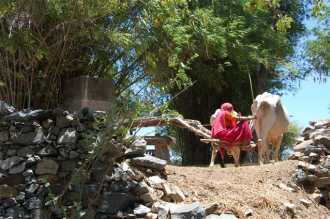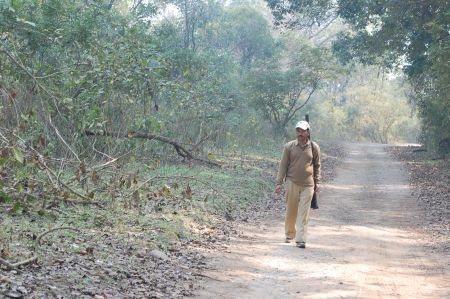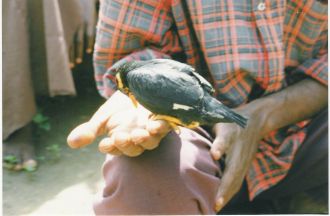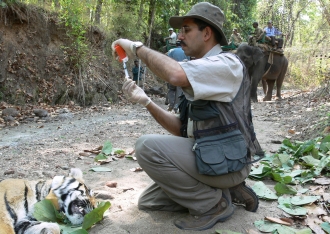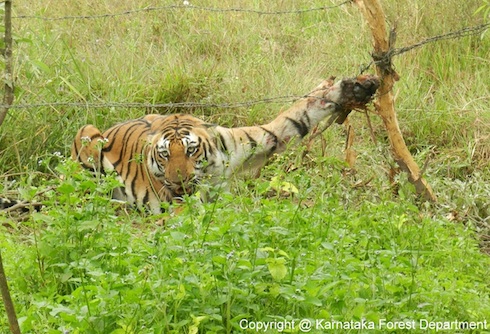Hanumantha Nayaka, 50, of Bairambadi village on Calicut Road, paid with his life for disturbing and provoking a tigress in a ravine in Karnatakas Bandipur Tiger Reserve he entered presumably to collect firewood on 13th March 2010.
Deputy Conservator of Forests Dr K Hanumanthappa, Bandipur Tiger Reserve, feels that Hanumantha Nayaka must have veered off the fire track in the core area, four kilometres inside the demarcation line, into a deep ravine to collect bamboo poles. It is an isolated incident caused perhaps by extreme provocation, he says.
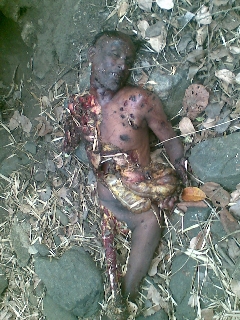
![]() The tiger's pug marks are clearly visible on the left shoulder of the deceased man. Pic: Karnataka forest department.
The tiger's pug marks are clearly visible on the left shoulder of the deceased man. Pic: Karnataka forest department.
All large carnivores are potential man-eaters. It is best to avoid close contact with wild animals especially large ones, adds Dr Y V Jhala, carnivore biologist and senior faculty at the Wildlife Institute of India.
An autopsy conducted by chief physician Dr Jagadeesh and chief medical officer Dr R Srinivas at the Gundlupet General Hospital in Chamrajnagar reveals that Nayaka died of internal hemorrhage, shock and trauma; not heart attack. The forest officials say that the big puncture marks on the throat indicate instant strangulation. The tigress tore off the right forearm, dislocated his wrist, right elbow, shoulder and collar bones; 5th to 10th rib bones on the right were missing, as was the right lung. Stomach entrails gouged out. The large intestine and the small intestine were pulled out. The entire pelvic cavity dislocated; penis, and buttocks eaten. The right thigh was eaten with the bone still clinging to the torso. All carnivores consume soft tissues first. Humans form a part of their diet, says Jhala.
Unanswered questions
1. Why did Hanumantha Nayaka venture so deep into the core area of the tiger reserve a good 4 kms inside the tiger reserves demarcation line (D Line) if he only wanted to collect firewood?
2. Was he alone? If yes, how could the villagers from the search party locate the corpse at the exact location within three hours after the incident? Forest officials say those who go to forests to collect firewood may not return the whole day or even night before the family gets worried and sets out to search.
3. If he had gone to collect firewood and the bundle of bamboo poles he had chopped were found, then where was the machete/axe he used to fell the bamboo/firewood?
The answers indeed point to the probability that Nayaka was accompanied by fellow villagers; perhaps, not just for firewood collection. Intelligence officials hinted at this entry being an attempt to smuggle tiger cubs for selling to circus groups. Poaching cliques get more and more creative with experience, they say.
Series
•
Tiger reserves, maternity wards
•
20,000 tigers is possible
•
Poacher nabbed, awaits trial
•
Revisiting Sansar Chand's arrest
•
Leopards face sustained threat
•
A coexistence gone wrong
•
Winning the battle
•
Interdependence and integration
•
Tigers introduced back in Sariska
•
Taking stock of Sariska
Carnivores that deliberately seek, kill, and eat humans are man-eaters; but not those that kill by chance encounter or accident and eat humans as this tigress did, explains Jhala.
Hanumanthappa makes the following observations to substantiate the Forest Departments claim that the carnivore was not a man-eater.
1. She did not display explicit intent to hunt the man. She attacked with intense anger under duress. She has carried the carcass all over the ravine indicating unusually aggressive behaviour. The fact that she shifted her cubs instantly to another location shows how insecure she felt.
2. There is no confirmation if the flesh was eaten by the tigress or if she abandoned the cadaver. Scavengers like jackals, vultures, wild boars, and hyenas might well have eaten up the entrails including the lung. According to Jim Corbett and Kenneth Anderson, Indias famed hunters of man-eating tigers of yore, tigers detest eating human flesh as it gets cumbersome to tear up the muscles. They are not wont to hunt, kill, and eat human beings. If this tigeress was a man-eater, it would have moved the kill to a secure location and consumed the flesh within the next three days. That the upset villagers crowded around the spot and did not let the forest staff keep a watch on the man-eater but instead, took the cadaver for last rites and autopsy, leaves scope for speculation that it might become a man-eater in future (see box 1).
3. Since the tigress has not ventured out of the reserve in search of cattle or human beings since this incident, it indicates that it is disinclined to consume human flesh. Prey is plentiful in Bandipur and the natural diet of tigers includes herbivores like sambhar, deer, gaur, or perhaps, all animals without much muscle to tear.
4. The forest officials say they have not observed any injured tiger in Bandipur, a primary cause that turns tigers into man-eaters.
5. There have been no further killings of human beings or cattle outside the tiger reserve either. This indicates fear of humans; prima facie, it is not a man-eater.
What can turn a carnivore into man-eater
1. Tigers, lions, leopards, or wolves can become man-eaters under certain stressful circumstances. But human flesh is definitely not a natural diet for them.
2. If a tiger or leopard kills a man, it is either disturbed in its habitat or gravely threatened.
3. Severe habitat loss and disturbance can lead a carnivore to man-eating behaviour -- like the man-eating panther of Kadur in Chickmaglur in FebruaryMarch 1996 (see box below).
4. If a tiger/leopard is injured with a thorn or a porcupine quill or a stone or is wounded in its paw, it cannot run or chase in a hunt. If the cat has a broken tooth, it cannot even tear the flesh. It leads to starving and death. In this window period, there are chances of the frail tiger going man hunting.
The history of Bairambadi
Bairambadi villagers are notorious for smuggling forest produce; in fact they smuggle nothing less than teakwood, rues Principal Chief Warden of Wildlife, Karnataka Forest Department, B K Singh. Bairambadi is one of the 200 villages surrounding the Bandipur Tiger Reserve, with a population of nearly 3000.
Concurring with this charge, Manikanta, a villager from Bairambadi, who works at Bandipur Safari Lodge, Jungle and Lodges, adds: the Bairambadi villagers are indeed notorious for forest offences. On an average, 4-5 cases are slapped against them every week.
Forest officials are firm that they will not declare it a man-eater -- sending out a message that anthropogenic conflict bears its risks. The victims family cannot claim compensation as the incident happened within the precincts of the tiger reserve. On humanitarian grounds, the Forest Department gave the family Rs 5000 in compensation on the day of the attack. The department has also promised the son of the deceased a temporary job in its anti-poaching camp in the tiger reserve. The department must at least keep this promise, says Siddappaji, nephew of Hanumantha Nayaka.
The widow Gopamma is in shock and has temporarily lost her voice. She gestures helplessly with a namaste towards her nephew. Despite the tragedy, the family bears no ill-will towards wildlife.
In areas of co-existence, it is advisable to have lifestyles that minimise contact with wildlife like temporal shift in human activities, to move about in groups, and to avoid twilight and night hours while outdoors, advises Jhala.
Kadurs man-eating panther
In December 1995, a colony of contractual migrant labourers who were employed by the Indian Railways to lay tracks between Arsikere and Kadur in Chickmaglur district in Karnataka were attacked by an epidemic. The illiterate migrant workers abandoned the carcasses of their colleagues who died of a virus in the open fallow fields between Berur and Kadur.
The blasting of rocks in the nearby Turuvanagudda, a leopard habitat, disturbed the carnivores. Additionally, rotting human flesh in the nearby fields confused the traumatised carnivores. After eating the decomposed human flesh which perhaps had lesser muscles than a freshly killed human being, at least one leopard took to man eating. In six weeks, four human beings were killed. In one instance, a four-year-old boy was attacked from a village near Berur right behind their house. But he survived the attack with grievous injuries. The boys sister saw the animal clearly. Trigger-happy hunters went ballistic with a bounty/trophy promised. The forest department had an executive order signed by the then PCCF (WL) to hunt and kill the errant man-eating panther.
Analysis - man-animal conflict
In India, Protected Areas are the prime real estate sites for construction of hydel power projects, mining, national highways, even housing projects. Grazing grounds for cattle spread veterinary infections to wildlife. With climate change and development accentuating habitat loss, it will become increasingly difficult to predict and document wildlife behaviour in the years to come. Wildlife Institute of India still does not have a wildlife psychology department. Even scientists have not been able to predict animal behaviour of traumatised wildlife.
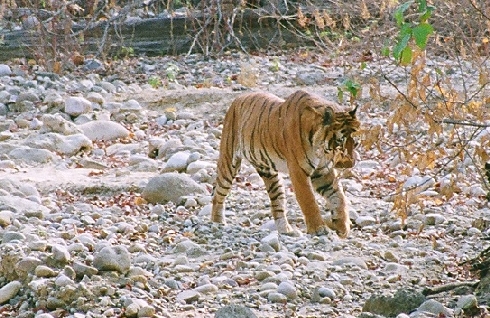
This male tiger was seen limping in Corbett tiger reserve with the left foreleg/ankle swollen. With a man eating tiger on the prowl in Katarniaghat east of Dudhwa Tiger Reserve that is contiguous to Corbett, foresters and activists were keeping a close watch on this tiger. Field director of Corbett Tiger reserve Ranjan Mishra said this tiger is old and frail, and is being accompanied by a tigress in the vicinity, forest department is keeping a very close watch on the injured tiger since May 2010. Pic: Arun Agnihotri, WWMC.
Man-animal conflict manifests in multiple ways. For instance, elephants raid the crops and farmlands owned by villagers living on forest fringes. Bears attack and venomous snakes bite humans. Man-eating tigers, leopards, bears, wolves, or lions are indeed very rare phenomena. It is usually humans that encroach on forest terrains causing acute trauma to wildlife due to loss of habitat.
Dean of Wildlife Institute of India Dr V B Mathur says: Only extreme stress must have provoked this tigress to attack a human being. At no cost can we endanger human lives. No one should enter the tiger terrain for the sake of ones own safety. We cannot afford to lose a single gene of the tiger gene pool in these times of tiger crisis.
DCF Hanumanthappa echoes similar concern: Not a blade of grass can be removed from the tiger reserve. Tiger reserves are notified and protected to sustain the entire faunal spectrum and natural ecosystem under Royal Bengal tiger.
That indeed is the ecological role of the tiger reserve; not just a passionate and futile attempt to create love for a wild animal.
How to hunt a man-eater
Jim Corbett and Kenneth Anderson, both hunters-turned-conservationists and writers of man-eater hunts, have written detailed descriptions of their field experiences. While Jim Corbett killed the infamous man-eater of Rudraprayag (a leopard) which had killed and eaten 123 human beings over five years, he took utmost care and even risked delaying gunning down of the beast for the fear of mistaking its identity. In the process, Corbett learnt a great deal about its behaviour and documented it.
Accordingly, a carnivore eats the soft tissues (including buttocks, thighs, stomach) immediately after killing. The next day it returns to consume the stomach entrails and other soft tissues if necessary by tearing it from limbs like upper arms, etc. The third day, it pulls out the flesh from the bones be they ribs, spinal chord or legs/limbs. Decomposition sets in by the fourth day with only the bones left. The uninterested carnivore leaves the remnants to the scavengers of the jungles like vultures, jackals, hyenas, wild boars, and very rarely bears.
Hunting for a man-eater entails guarding over the human kill made by the tiger/leopard or any other carnivore. It is of utmost importance to keep the area sterile of all human presence. Despite emotions running high, it is essential to convince the victims family that last rites are not necessary as it is important to watch and ward over the kill so that more human lives are not lost. Human presence in the immediate vicinity of the spot of attack will trample upon the blood trail and the human scent will scare the man-eater from coming to its kill. By guarding over the kill, forest guards can ascertain if the man-eater is indeed a tiger or a leopard or a bear or wolf.
On the first or second day when the carnivore descends on its kill to consume soft tissues, it is instinctively afraid and watches over its shoulder nervously for anyone hunting for it. That is the surest sign that it is the culprit. When the carnivore returns to eat its kill by the third day, an armed hunter should wait and kill it instantly in one shot. If it escapes with a bullet injury, it will turn vindictive.
While senior wildlife biologist Dr Ullas Karanth of the New York-based Wildlife Conservation Society is of the view that a man-eater has to be killed, there is increasing pressure to save every single gene in the genetic pool of the endangered tigers.





